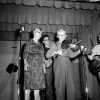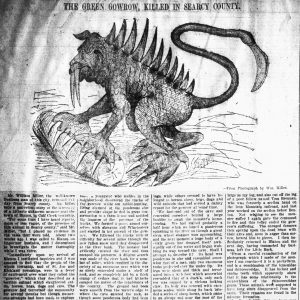calsfoundation@cals.org
Gowrow
The gowrow, one of several fabulous monsters reported in Arkansas popular lore, may owe its origins more to journalism than to traditional narrative and folk belief. The principal documentation of the creature’s existence is a story that appeared in the Arkansas Gazette on January 31, 1897, apparently written by Elbert Smithee. Elmer Burrus provided an illustration, allegedly based on a photograph, to accompany the piece.
Fred W. Allsopp, who edited the Gazette at the time, recounted the circumstances that led to Smithee’s story. William Miller, a Little Rock businessman who had been traveling in the Ozarks of northwest Arkansas, told Smithee of a “horrible monster” known as the gowrow. Its name came from the noise it made during its nocturnal depredations. The creature had been slaughtering livestock and pets near Blanco (Searcy County) in Calf Creek Township. Miller formed a posse that tracked the gowrow to its lair, a cave littered with animal skeletons and even some human remains. As they waited to ambush the monster, they heard it emerge from a nearby lake, causing the earth to tremble as it made its way toward them. The gowrow perished after several volleys from the posse. Before its death, it ripped up several trees and tore off the leg of one of the posse members.
An examination of the remains revealed a creature twenty feet in length with two tusks, large webbed feet ending in claws, a row of short horns along its back, and a long thin tail with a blade on the end. Williams claimed to have sent the body to the Smithsonian Institution, but it never arrived at the Washington DC museum. Allsopp dismissed the account: “It was a great fake, probably without foundation in fact.”
The Ozark research of folklore collector Vance Randolph revealed additional details about the gowrow, which he believed had been reported as early as the 1880s. Randolph’s sources suggested that the gowrow was a species of creature rather than an individual monstrosity. The young hatched from soft-shelled eggs as large as beer kegs, and the mother carried newly hatched infants in a pouch. Randolph related a story about an encounter with a gowrow by a spelunker exploring Devil’s Hole in Boone County. He also told of someone from Mena (Polk County) who claimed to have captured a gowrow by inducing the creature to eat so many dried apples that it swelled to a size that prevented its escaping into its burrow. The gowrow’s captor was exhibiting his catch to anyone who would pay a quarter. Once he had a sufficient audience, the man would stagger from behind a curtain with his clothes in rags announcing that the gowrow had escaped. This sent the crowd into a panic without his having to produce an actual gowrow.
Creatures such as the gowrow abound in the folklore of exaggeration that is often associated with the frontier. Though sometimes stories about them may be told as true, more frequently they are tall tales or “lies,” as some storytellers denominate them. In fact, Randolph presented his material on the gowrow in his collection of tall tales titled We Always Lie to Strangers.
For additional information:
Allsopp, Fred W. Little Adventures in Newspaperdom. Little Rock: Arkansas Writer, 1922.
“The Green Gowrow, Killed in Searcy County.” Arkansas Gazette. January 31, 1897, p. 16.
Randolph, Vance. We Always Lie to Strangers: Tall Tales from the Ozarks. New York: Columbia University Press, 1951.
William M. Clements
Arkansas State University


 Gowrow Article
Gowrow Article 



Comments
No comments on this entry yet.